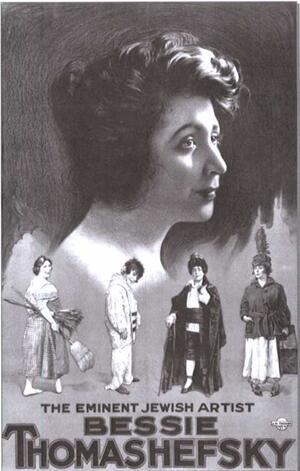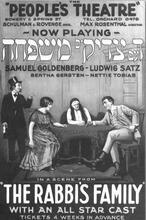Bessie Thomashefsky
With suffragist spirit and comedic skill, Bessie Thomashefsky adapted great American and British plays for Yiddish-speaking audiences. Thomashefsky immigrated to Baltimore in 1883 and began working in a sweatshop at age twelve. At fourteen, she saw Boris Thomashefsky performing in a Yiddish play, joined the company a few years later, and married Boris in 1891. At Boris’ People’s Theater in New York, Bessie Thomashefsky performed Yiddish adaptations of plays by Chekov, Wilde, and Shakespeare, as well as modern Yiddish creations. She played several strong women, including the leads in Minke, the Housemaid, and Jennie Runs for Mayor. Although she separated from Boris, she ran the People’s Theater from 1915 to 1919 and renamed it for herself. She retired in 1930, wrote a memoir, and moved to California.
Bessie Thomashefsky, Yiddish actor and comedian, delighted audiences for over thirty years with leading roles in New York, and later on tour throughout the United States, in London and in Toronto.
Early Life
Born Brukhe Baumfeld-Kaufman in Kiev, Ukraine, Bessie Thomashefsky and her family arrived in America and settled near Baltimore in 1883. She attended school for two years until she was twelve and then went to work in a stocking factory and a sweatshop. At fourteen, she saw a Yiddish play that starred the young Boris Thomashefsky (1866–1939), who was then performing the women’s roles in the company. A few years later, she joined the Thomashefsky Players and married Boris in 1891. Although she was overcome with fright the first time she appeared onstage, she soon became the star of the company, playing the parts she had first seen her husband perform.
The People’s Theater
Boris Thomashefsky opened the People’s Theater in New York City, intending to bring Chekhov and Shakespeare to Yiddish-speaking audiences. Bessie starred in melodramas such as The Kreutzer Sonata and The Broken Fiddle and created the character of Beynishl in The Yeshiva Boy by Zolatarevsky.
As immigrants demanded more and more to see American plays, in 1901 the People’s Theater staged a Yiddish version of Uncle Tom’s Cabin. Like Irving Berlin, Boris Thomashefsky wrote songs such as “Der Yidisher Baseball Game” and “Der Yidisher Yankee Doodle,” many of which Bessie Thomashefsky made famous. In 1911 she starred in Das Meydl fun West, a Yiddish version of David Belasco’s Girl of the Golden West. In 1915 her husband wrote Di Sheyne Amerikaner [The beautiful American] for Thomashefsky, who shocked and delighted audiences by playing an emancipated woman in a riding costume.
Career Successes
Three of her most famous roles were in plays with strong suffragist and women’s rights themes: Minke, the Housemaid, a Yiddish Pygmalion in which the maid-transformed-into-lady rejects Henry Higgins; Chantzie in America, a musical about an immigrant girl who assumes a male identity in order to be allowed to drive a car; and Jennie Runs for Mayor, a play about the first woman candidate for mayor.
Boris’s womanizing eventually led to a separation in 1911. In an extraordinary move, Bessie Thomashefsky took over the management of the People’s Theater in 1915 and the following season the theater was renamed Bessie Thomashefsky’s People’s Theater. Taking over some of Boris’s best-known roles, Bessie starred in the Yiddish version of Hamlet, emulating Sarah Bernhardt, who startled audiences when she first appeared in that role. She was also an accomplished comedian, taking roles formerly performed by the comic genius Siegmund Mogulescu. These included the hugely popular Green Boy and Green Girl plays. Bessie Thomashefsky starred in so many of these Green roles that she was, for a time, called the “Salad Queen of Second Avenue.”
One of her most popular roles was as Suzi Bren in Zolatarevsky’s play of the same name, a part that may have reflected Sophie Tucker’s fame as the “Red Hot Mama.” There can be little doubt that Thomashefsky served as a model for Fanny Brice, Molly Picon, and even Barbara Streisand.
In 1919, her name was removed from the People’s Theater and she separated from Boris Thomashefsky in 1922. She continued to appear in both Yiddish- and English-language plays and in vaudeville, touring the United States, and performing in London and Toronto. She retired in 1930. She had two sons, Harry and Teddy, and was the grandmother of conductor Michael Tilson Thomas. Bessie Thomashefsky lived in California until her death on July 6, 1962. Her memoir, Mayn lebens geshikhte (My life’s history: The joys and tribulations of a Yiddish star actress), as told to A. Tennenholz, was published in 1915.
Legacy
Few if any accounts of Bessie Thomashefsky’s professional career exist in English, where she is described only as “wife of” and “mother of.” The history of her career in the Lexicon of the Yiddish Theatre is probably the only account of her stage career in print today.
In 2005 Michael Tilson Thomas, now the music director of the San Francisco Symphony Orchestra, created a multi-media homage to his grandparents. The Thomashefskys: Music and Memories of a Life in the Yiddish Theater premiered at Carnegie Hall in New York in April of that year, with an on-stage band, singers and actors and Thomas as conductor and narrator.
AJYB 65:438.
EJ, s.v. “Thomashefsky, Boris”.
Lexicon of the Yiddish Theatre. Edited by Zalman Zylbercwajg. Vol. 2 (1934): 840–845.
Obituary. NYTimes, July 8, 1962, 65:2.
UJB, s.v. “Thomashefsky, Boris.”





